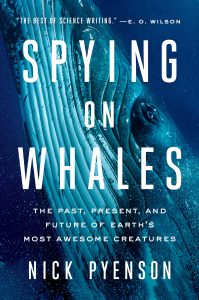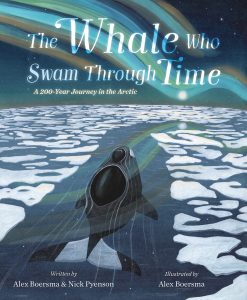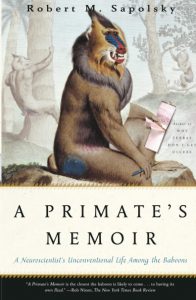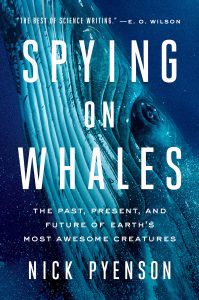Read Together: Spying on Whales by Nick Pyenson
 In July we are taking a deep dive into the lives of some of the largest, most intelligent species to have ever lived on our planet with our community read, Spying on Whales: the Past, Present, and Future of Earth's Most Awesome Creatures. Whales evolved from land-roaming, dog-sized creatures into animals that move like fish, breathe like us, can grow to 300,000 pounds, live 200 years and travel entire ocean basins. During July Spying on Whales is available with no holds as an ebook on Libby. We’re excited to meet author Nick Pyenson July 19, 7pm via Zoom. Bring your questions about whales, research and working for the Smithsonian. Register for the Zoom link.
In July we are taking a deep dive into the lives of some of the largest, most intelligent species to have ever lived on our planet with our community read, Spying on Whales: the Past, Present, and Future of Earth's Most Awesome Creatures. Whales evolved from land-roaming, dog-sized creatures into animals that move like fish, breathe like us, can grow to 300,000 pounds, live 200 years and travel entire ocean basins. During July Spying on Whales is available with no holds as an ebook on Libby. We’re excited to meet author Nick Pyenson July 19, 7pm via Zoom. Bring your questions about whales, research and working for the Smithsonian. Register for the Zoom link. Pyenson's work studying whales
Dr. Nick Pyenson is the curator of fossil marine mammals at the Smithsonian Institution’s National Museum of Natural History in Washington, D.C. His work has taken him to every continent. Pyenson's scientific discoveries appear frequently in The New York Times, The Washington Post and National Geographic, as well as on NPR, NBC, CBC and the BBC. He took an interest in whales during his graduate studies in evolutionary biology. “I realized the stories of how and when whales came to be still hadn't been fully told. They have left so many fossils over the past 55 million years, and more questions than answers,” Pyenson said. “Following the whale trail led me to so many interesting people, places, and more questions.” Pyenson is often asked which whale is his favorite. He said he doesn’t like to pick among living whales because he finds fascinating aspects to all of them. Instead he shared some interesting facts about a few of his favorite extinct whales. “Odobenocetops was a walrus-faced whale that lived off the coast of South America until a few million years ago. Llanocetus was snaggle-toothed baleen whale that was gigantic for its time, and its 32 million year-old fossils have only been collected from Seymour Island in Antarctica. Pakicetus, one of the earliest whales, had four legs and skull the size of big dinner plate,” Pyenson said. He co-authored the children’s book The Whale Who Swam Through Time with science illustrator Alex Boersma. It’s a gorgeous picture book about the 200-year life of a Bowhead whale. I recommend it for adults as well as kids. Read on to learn more about Pyenson's journey and for a few book recommendations. We’ll see you July 19 at 7pm.
He co-authored the children’s book The Whale Who Swam Through Time with science illustrator Alex Boersma. It’s a gorgeous picture book about the 200-year life of a Bowhead whale. I recommend it for adults as well as kids. Read on to learn more about Pyenson's journey and for a few book recommendations. We’ll see you July 19 at 7pm. Full interview with author Nick Pyenson
 You’ve made a career of learning all that you can about whales. What first sparked your interest?
You’ve made a career of learning all that you can about whales. What first sparked your interest?
Whales weren't always in the picture for me; instead, I was always interested in museums, travel, and science. When I realized that I didn't have the hunger for medical school, graduate school in evolutionary biology seemed like the right mix of creativity, opportunity, and dedication that I wanted. While in grad school, I realized that the stories of how and when whales came to be still hadn't been fully told: they have left so many fossils over the past 55 million years, and more questions than answers. Following the whale trail led me to so many interesting people, places, and more questions. I suppose what excited me even more than the amazing aspects of their lives is how they can continually answer interesting questions. If you're lucky, the best questions never get fully answered. Can you tell us a little more about what it means to be a curator of fossil marine mammals at the Smithsonian Institution’s National Museum of Natural History?
I like to say there is no typical day as a museum curator at the Smithsonian. My job is varied, even if it has specific pillars: carry out original, publishable research; help caretake and grow the National Collections; mentor and serve the science community; and then communicate all of this work to a broad audience. I'll put it another way: some days I'm on a boat in the Antarctic tagging whales with suction-cupped devices; other days I'm looking for the fossils in deserts; still other days, I'm updating archival materials on 19th century specimens in our collections databases. I'd say the best days are working on problems with people and figuring out a solution; and the occasional tour behind-the-scenes. It's great to inspire folks with real parts of the American story.What’s the question you are asked most often about whales?
Probably one of the more frequent is "what's your favorite whale?" And it's not an easy answer! There's something interesting to me about each of the living species, so instead I'll tell you about some of my favorite extinct ones. Odobenocetops was a walrus-faced whale that lived off the coast of South America until a few million years ago. Llanocetus was snaggle-toothed baleen whale that was gigantic for its time, and its 32 million year-old fossils have only been collected from Seymour Island in Antarctica. Pakicetus, one of the earliest whales, had four legs and skull the size of big dinner plate.Of course I have to ask, have you spent much time in libraries? Any library love you’d like to share?
Tons of time! I love libraries. They're portals for so many people, and I'd want to give a shout out to two in particular: my local Hyattsville Branch Library of Prince George's County in Maryland; and the Sitka Public Library in Alaska, which I visited frequently when I lived there for a winter – they have a T. rex head crashing through their ceiling that's truly awesome.What do you like to read in your free time and what books do you recommend?
 These days, I try to read more fiction than I did as a kid. I am finally finishing Station Eleven. Some books that I'll always open include The English Patient and A Primate's Memoir. Right now, I'm reading a few Rebecca Solnit books my sister gave me. I'm also enjoying my friend Alex Dehgan's The Snow Leopard Project, which is all about creating a national park in a conflict zone – a bit far from whales, but it grapples with real issues in conservation that matter for any species (including us). For whales, you should always start with Moby Dick. And then you would do yourself a favor to follow-up by reading Bathsheba Demuth's Floating Coast.
These days, I try to read more fiction than I did as a kid. I am finally finishing Station Eleven. Some books that I'll always open include The English Patient and A Primate's Memoir. Right now, I'm reading a few Rebecca Solnit books my sister gave me. I'm also enjoying my friend Alex Dehgan's The Snow Leopard Project, which is all about creating a national park in a conflict zone – a bit far from whales, but it grapples with real issues in conservation that matter for any species (including us). For whales, you should always start with Moby Dick. And then you would do yourself a favor to follow-up by reading Bathsheba Demuth's Floating Coast. 











